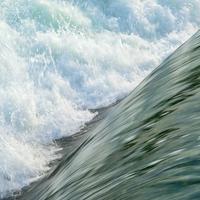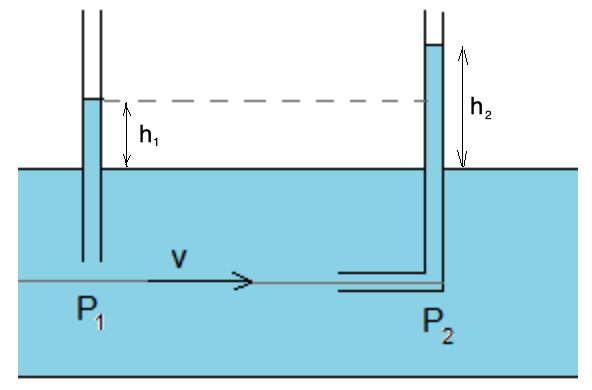 Fluid dynamics is the study of moving fluids. As with moving bodies, mass and energy are conserved leading to equations that can be used to determine unknown quantities. An understanding of fluid properties enables us to calculate drag forces and the categorization of fluid flow.
Fluid dynamics is the study of moving fluids. As with moving bodies, mass and energy are conserved leading to equations that can be used to determine unknown quantities. An understanding of fluid properties enables us to calculate drag forces and the categorization of fluid flow.
Key Concepts
Flowlines show the movement of particles in a fluid.
Streamlines follow the velocity vectors of particles in a fluid. As with all vectors, streamlines will never intersect as they show the resultant velocity. The closer the streamlines, the higher the velocity.
For steady flow, flowlines and streamlines will be indistinguishable.
Conservation of mass
Mass is conserved in fluid flow. This means that mass flowrate is constant: the mass of fluid arriving at any point must equal the mass leaving the point in any given period of time. This is a statement of continuity. Mass flowrate is the mass passing a point per unit time.
Continuity equation
Since density is constant for incompressible (ideal) fluids, if mass flowrate is constant, volumetric flowrate must be constant:
\(Av=\text{constant}\)
- \(A\) is cross-sectional area of the container (m2)
- \(v\) is velocity of the fluid (ms-1)
The velocity of a fluid increases as the radius of a pipe decreases.
Mass is not the only conserved quantity in a moving fluid; energy is also conserved. In steady flow, the sum of kinetic energy, potential energy and internal energy remains constant. One consequence is Bernoulli's principle.
Bernoulli's principle states that an increase in the speed of a fluid occurs simultaneously with a decrease in pressure or a decrease in the fluid's potential energy. The resulting equation is:
\({1\over 2}\rho v^2+\rho gz+p=\text{constant}\)
- \(\rho\) is fluid denisty (kg m-3)
- \(v\) is velocity (ms-1)
- \(g\) is gravitational field strength (on Earth, 9.81 N kg-1)
- \(z\) is height (m)
- \(p\) is pressure (Pa)
There are many applications of the Bernoulli equation including flow out of a container, determining the speed of a plane and venturi tubes.
Pitot tubes
The speed of a plane can be measured using a pitot tube. As the plane flies, there is relative motion between the plane and the air.

A tube points directly forwards to collect the air and is connected to a manometer to measure the dynamic pressure, the pressure caused by the relative motion of the plane and the air:
\(\Delta p=\rho_f g\Delta h\)
- \(\Delta p\) is the dynamic pressure (Pa)
- \(\rho_f\) is the density of the fluid in the manometer tube (kg m-3)
- \(g\) is gravitational field strength (on Earth, 9.81 N kg-1)
- \(\Delta h\) is the height difference in the U-tube (m)
By Cmglee - Own work, CC BY-SA 4.0, https://commons.wikimedia.org/w/index.php?curid=74391265
If we assume that the air is incompressible, Bernoulli's equation applies. The pitot tube is horizontal, so there is no height difference and the air is stopped as it reaches the manometer:
\({1\over 2}\rho_a u^2+\Delta p=0\)
\(\Rightarrow {1\over 2}\rho_a u^2=-\Delta p\)
- \(\rho_a\) is the density of the air (kg m-3)
- \(u\) is the relative velocity of the air and the plane (ms-1)
- \(\Delta p\) is the dynamic pressure (Pa)
Venturi meter
A Venturi meter is a device for measuring the pressure of a fluid. A constriction is made in a pipe to reduce cross-sectional area, which, according to continuity, increases velocity:
\(A_1v_1=A_2v_2\)
- \(A\) is cross-sectional area (m2)
- \(v\) is velocity (ms-1)
If the pipe is horizontal, the pressure must decrease to satisfy Bernoulli's principle. Applying Bernoulli's equation:
\({1\over 2}\rho {v_1}^2+p_1={1\over 2}\rho {v_2}^2+p_2\)
- \(\rho\) is fluid density (kg m-3)
- \(v\) is velocity (ms-1)
- \(p\) is pressure (Pa)
Vertical 'Venturi' tubes above the initial section and the constriction are open to the atmosphere. The pressure difference can be determined from the difference in the heights the the fluid reaches:
\(p_1-p_2=\rho g \Delta h\)
- \(p\) is pressure (Pa)
- \(\rho\) is fluid denisty (kg m-3)
- \(g\) is gravitational field strength (on Earth, 9.81 N kg-1)
- \(\Delta h\) is the height difference in the Venturi tubes (m)
The drag force on a spherical object in a fluid can be calculated using Stokes’ law:
\(F_D=6\pi \eta rv\)
- \(F_D\) is drag force (N)
- \(\eta\) is viscosity (Pa s)
- \(r\) is the radius of the sphere (m)
- \(v\) is velocity (ms-1)
By Kraaiennest - self-madeBased on: G.K. Batchelor (1967) An introduction to fluid dynamics, Cambridge University Press. Pages 230–235., CC BY-SA 3.0, https://commons.wikimedia.org/w/index.php?curid=4115921
This equation applies only for low Reynolds numbers when flow is laminar. Note that the drag force increases with velocity.
Viscosity of a fluid is its resistance to deformation. For example, treacle has a higher viscosity than water.

It emerges from the friction between adjacent layers of fluid in relative motion, such as when fluid flows faster in the centre of a pipe than at the walls. The higher the viscosity, the higher the pressure difference required to sustain fluid flow throughout a pipe.
Fluid flow can be categorised as laminar (a) or turbulent (b).
Laminar
In laminar flow, particles in the fluid follow smooth paths in layers with no mixing. Motion is orderly with particles close to the walls of a pipe moving in straight lines parallel to the walls. Laminar flow occurs at low velocities in fluids of high viscosity, below a Reynolds number threshold at which the flow becomes turbulent. Stokes' law applies and drag forces are low.
Turbulent
In turbulent flow, fluid particles experience changes in pressure and flow velocity due to excessive kinetic energy in a fluid of low viscosity. Vortices and eddy currents develop causing mixing of the layers of fluid. The Reynolds number exceeds the threshold for laminar flow and Stokes' law does not apply.
Examples include storm clouds, smoke from a chimney and fast-flowing rivers. An advantage of turbulent flow is a reduction of lift, as required in Formula 1 racing.
Laminar and turbulent flow can be distinguished by observation or by calculation. The latter requires determination of the Reynolds number, a dimensionless value for fluid flow:
\(R={vr\rho \over \eta}\)
- \(R\) is Reynolds number (dimensionless)
- \(v\) is velocity (ms-1)
- \(r\) is the radius of the pipe (m)
- \(\rho\) is fluid density (kg m-3)
- \(\eta\) is viscosity (Pa s)
Laminar flow conditions prevail for \(R<1000\).
Use flashcards to practise your recall.
Use quizzes to practise application of theory.
START QUIZ!
AHL fluid dynamics 1/1
This image represents an ideal fluid flowing in a pipe:

Calculate \(v_1\over v_2\) if \({A_1\over A_2} = 4\).
\(Av=\text{ constant}\)
\({v_1\over v_2}={A_2\over A_1}\)
This image represents an ideal fluid flowing in a pipe:

Continuity tells us that mass flowrate is constant. This fluid is incompressible (ideal) so volumetric flowrate is constant.
This image represents water flowing in a pipe:

If \(v_1\) is 1 ms-1 and \(v_2\) is 4 ms-1, calculate the difference in pressure.
Using Bernoulli's equation for horizontal fluid flow:
\(p_1 + {1\over 2}ρ{v_1}^2 = p_2 + {1\over2}ρ{v_2}^2\)
\(p_1 - p_2 = {1\over2} ρ{v_2}^2 - {1\over 2}ρ{v_1}^2=500(4^2-1^2)=7500\text{ Pa}\)
This image represents water flowing in a pipe:

Using Bernoulli's equation for horizontal fluid flow:
\(p_1 + {1\over 2}ρ{v_1}^2 = p_2 + {1\over2}ρ{v_2}^2\)
\({1\over2} ρ{v_2}^2 - {1\over 2}ρ{v_1}^2=p_1 - p_2\)
\(500({v_2}^2-4^2)=4500\)
\(v_2 = 5\)
This image is from the PhET Fluid Flow simulation:
.png)
If the fluid is water and the difference in height is 2 m, determine the pressure in the higher section of pipe.
Using Bernoulli's equation for constant speed:
\(p_1+\rho g z_1=p_2+\rho gz_2\)
\(p_1-p_2=10\text{ }000(z_2-z_1)=20\text{ kPa}\)
\(p_2 =98\text{ kPa}\)
This diagram represents water flowing out of a small hole in a bucket:

If \(h\) = 10 cm, calculate the velocity of water coming out of the hole.
Using conservation of energy or Bernoulli's equation:
\(v = \sqrt{2}gh\)
Note: the velocity does not depend on the diameter of the hole. However, flow rate would.
This image is from the PhET Fluid Flow simulation:

We can see that \(p_1\) = 105.132 kPa and \(p_2\) = 87.437 kPa. If the flow rate is increased...
1 and p2 decrease but p1 - p2 stays the same.
1 and p2 increase but p1 - p2 decreases.
If flow rate is increased for the same cross-sectional area, then velocity is increased. The pressure is reduced.
This image is from the PhET Fluid Flow simulation:

We can see that \(p_1\) = 105.132 kPa and \(p_2\) = 87.437 kPa. If the left side was lowered...
The left side would be deeper and therefore at higher pressure.
The right hand side remains at the same height and so pressure is the same. While one might think that the greater height difference would cause a reduction in the right hand pressure, this is compensated for by the increased pressure on the left.
Still unconvinced? Imagine that the right hand side was exposed to the atmosphere. Then there would clearly be no effect from simply lowering another part of the pipe.
The diagram shows a pitot static tube.

If the flow rate was increased...
\(p_1\) would decrease due to the increase in \(v\).
\(p_2\) remains the same as velocity here is still zero.
Two 25 m diameter spheres are released above the Earth.

The mass of the blue sphere is 40 kg and the red 30 kg. Compared to the red sphere, the blue will have...
The buoyancy on each is the same. Resolving forces at the start:
\(ma=mg-B\)
\(a={mg-B\over m}=g-{B\over m}\)
The red ball has a larger mass and therefore a larger acceleration as the fractional term is smaller.
Resolving forces at terminal velocity, drag + buoyant force = weight. As the weight is higher for the red ball, a larger velocity will be required for the drag to be sufficient to balance the forces.
How much of AHL Fluid dynamics have you understood?
Feedback
Which of the following best describes your feedback?
Notes
Report a problem for flashcard
Your best time:


 Twitter
Twitter  Facebook
Facebook  LinkedIn
LinkedIn